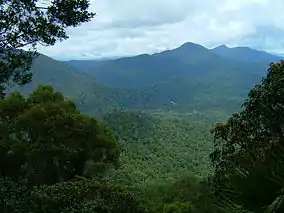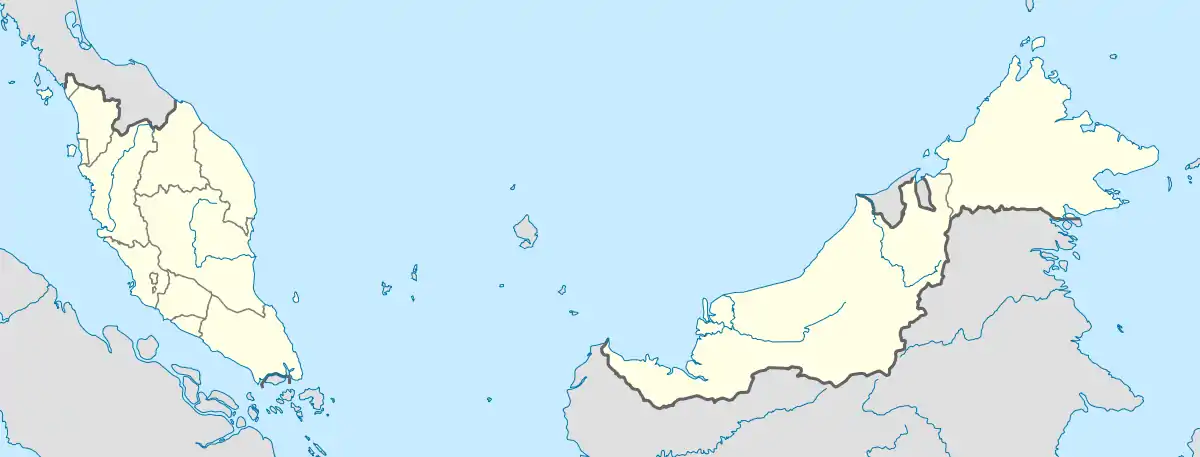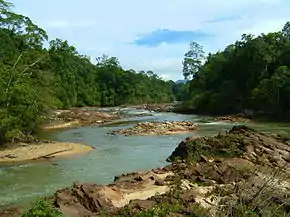Endau-Rompin National Park
Endau-Rompin National Park (Malay: Taman Negara Endau-Rompin) is a protected tropical rainforest in the southernmost prolongation of the Tenasserim Hills, Malaysia. It is south of the state of Pahang and northeast of Johor covering an area of approximately 870 km2 (340 sq mi), making it the second-largest national park in Peninsular Malaysia after Taman Negara. It has approximately 26 km (16 mi) of trail. It is the second national park proclaimed by the government of Malaysia. Gunung Besar, the second-highest peak in Johor, is in the park.
| Endau-Rompin National Park Taman Negara Endau-Rompin | |
|---|---|
IUCN category II (national park) | |
 View from the top of Janing Barat. | |
 Endau-Rompin | |
| Location | Johor and Pahang, Peninsular Malaysia |
| Nearest city | Kahang |
| Area | 870 km2 (340 sq mi) |
| Established | 1993 |
| Governing body | Johor Park Corporation |
The park takes its name from the Endau and Rompin rivers that flow through the park. Other rivers that flow through the park are the Segamat, Selai, and Jasin.
There are two official entry points to the park: the Kampung Peta entrance located along the eastern boundary in Mersing District, and the Selai entrance at the southwestern boundary in Segamat District.
During the monsoon season from November till March, the park is closed to the public. Fishing is banned from September till October during mating season.
History

The first scientific study of the area was conducted in 1892 by H.W. Lake and Lieutenant H.J. Kelsall. With the aid of the study, the forest complex of Endau-Kluang was gazetted as a forest reserve in 1933. Later in 1972, the forest reserve was expanded to include Lesong forest reserve in Pahang.[1]
In the same year, the federal government came up with a proposal to federally protect 2,000 km² of the complex as a national park. At that time there was no legal mechanism to create a national park. In 1980, the National Parks Act 1980 (Malaysia) was passed by the Malaysian Parliament. However, dispute between federal and state powers prevented the creation of a national park in the area at that time.[2] Five years later, the Department of Wildlife and National Parks proposed roughly the same areas to be gazetted as wildlife sanctuary to protect the critically endangered Sumatran rhinoceros.[2]
Flora and fauna
Endau-Rompin is one of the oldest tropical rainforest complexes in the world and features rock formations some 248 million years old.
Mammals endemic to Endau-Rompin include the Malayan tiger, Indochinese leopard, Clouded leopard, Asian golden cat, Leopard cat, Marbled cat, Asian elephant, Malayan tapir, Bornean bearded pig, Banded pig, Barking deer, Sambar deer, Lesser mouse deer, Greater mouse deer, Sunbear, Long-tailed macaque, Pig-tailed macaque, Dusky leaf monkey and Banded Langur.
It used to have the largest remaining population of the threatened Northern Sumatran rhinoceros species on the Malay Peninsula, but they are now extinct in the wild for the whole of Malaysia.[3]
The Gollum's toad, Ingerophrynus gollum, is only known from the Endau-Rompin National Park.[4][5]
See also
- Belum-Temengor
- List of national parks of Malaysia
References
- Journey Malaysia. Endau Rompin National Park. Extracted April 24, 2007
- Malaysian Nature Society. Endau Rompin National Park Archived 2007-09-28 at the Wayback Machine. Extracted April 24, 2007
- https://news.nationalgeographic.com/2015/09/150930-sumatran-rhino-extinction-indonesia-animals-conservation/
- "Ingerophrynus gollum". Amphibians and Reptiles of Peninsular Malaysia. Retrieved 8 March 2018.
- Frost, Darrel R. (2018). "Ingerophrynus gollum Grismer, 2007". Amphibian Species of the World: an Online Reference. Version 6.0. American Museum of Natural History. Retrieved 8 March 2018.
External links
| Wikimedia Commons has media related to Endau-Rompin National Park. |
- Tourism Malaysia - Endau Rompin National Park
 Endau-Rompin National Park travel guide from Wikivoyage
Endau-Rompin National Park travel guide from Wikivoyage- e-Tourism Portal - Virtual Malaysia
- Travel Ideas - Malaysia Social Travel Channel